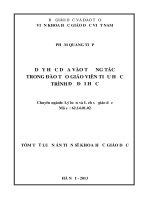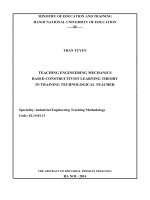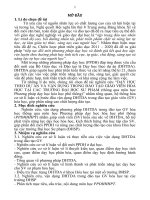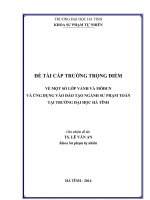ỨNG DỤNG DẠY HỌC DỰ ÁN TRONG ĐÀO TẠO GIÁO VIÊN KỸ THUẬT TẠI TRƯỜNG ĐẠI HỌC KỸ THUẬT CÔNG NGHIỆP - ĐẠI HỌC THÁI NGUYÊN
Bạn đang xem bản rút gọn của tài liệu. Xem và tải ngay bản đầy đủ của tài liệu tại đây (1.65 MB, 8 trang )
<span class='text_page_counter'>(1)</span><div class='page_container' data-page=1>
<b>Tập 167, số 07, 2017</b>
Tập 167
, Số
07
</div>
<span class='text_page_counter'>(2)</span><div class='page_container' data-page=2>
<i><b> </b></i>
<b>Tạp chí Khoa học và Công nghệ</b>
<b>CHUYÊN SAN KHOA HỌC XÃ HỘI – NHÂN VĂN – KINH TẾ</b>
<b>Môc lôc </b> <b>Trang</b>
<b>Nguyễn Đại Đồng - Hoạt động khai thác mỏ ở Lào Cai dưới thời Gia Long và Minh Mệnh </b> 3
<b>Dương Thị Huyền - Thương mại châu Âu và những tác động đến tình hình chính trị Đàng Trong thế kỷ XVI- XVIII </b> 9
<i><b>Trần Thị Nhung - Miêu tả tình tiết trong Truyện Kiều và Kim Vân Kiều Truyện </b></i> 15
<i><b>Nguyễn Thị Hải Phương - Bản chất của ngôn từ văn học (nghĩ từ bài viết Bản chất xã hội, thẩm mỹ của diễn </b></i>
<i><b>ngôn văn học của Trần Đình Sử) </b></i> 21
<b>Phạm Thị Mai Hương, Nguyễn Thị Thu Trang, Ngô Thị Lan Anh - Ảnh hưởng của lễ hội Vu Lan đến đời </b>
sống đạo đức của nhân dân huyện Quốc Oai, Hà Nội 25
<b>Phạm Thị Ngọc Anh - Hình tượng văn thủy ba trong mỹ thuật cổ Việt Nam và các ứng dụng trên sản phẩm mỹ </b>
<i>thuật tạo hình hiện đại </i> 31
<b>Trương Thị Phương - Giải pháp ứng dụng hiệu quả thông tin đồ họa trên báo điện tử </b> 37
<b>Phạm Thị Nhàn - Ẩn dụ từ vị giác “ngọt” trong tiếng Hán hiện đại </b> 43
<i><b>Lương Thị Thanh Dung – Sự khác nhau về kết cấu chữ Nôm của văn bản Thiền tông bản hạnh giữa bản in </b></i>
<b>năm 1745 và bản in năm 1932 </b> 49
<b>Nguyễn Thị Quế, Phạm Phương Hoa - Đánh giá sự phù hợp của giáo trình New English File đối với việc </b>
<b>giảng dạy sinh viên không chuyên ngữ tại Trường Đại học Khoa học – Đại học Thái Nguyên </b> 55
<b>Hoàng Thị Thắm - Nghiên cứu về siêu nhận thức trong nghe tiếng Anh của sinh viên chương trình tiên tiến tại </b>
<b>Trường Đại học Kỹ thuật Công nghiệp – Đại học Thái Nguyên </b> 61
<b>Nguyễn Quỳnh Trang, Dương Công Đạt, Vũ Kiều Hạnh - Thiết kế chương trình bổ trợ nói cho học sinh lớp </b>
<b>10 Trường Trung học Phổ thông Thái Nguyên </b> 67
<b>Nguyễn Khánh Như - Sự phát triển của hệ thống các trường đại học sư phạm trọng điểm Trung Quốc hiện nay </b> 73
<b>Nguyễn Văn Hồng, Vũ Thị Thanh Thủy - Dạy học theo dự án và vấn đề phát triển năng lực nghiên cứu khoa </b>
học cho học sinh trong dạy học Sinh thái học ở trung học phổ thông 79
<b>Trần Thị Phương Thảo, Nguyễn Thị Hoa Hồng - Nâng cao tính ứng dụng trong xây dựng chương trình đào </b>
tạo đại học tại Việt Nam – bài học từ chương trình giáo dục đại học định hướng nghề nghiệp ứng dụng (POHE) 85
<b>Phạm Thị Bích Thảo, Nguyễn Thành Trung - Lựa chọn bài tập thể lực chuyên môn nâng cao kết quả học tập </b>
<b>chạy cự ly ngắn cho sinh viên khóa 14 Trường Đại học Khoa học - Đại học Thái Nguyên </b> 91
<b>Lê Huy Hoàng, Nguyễn Thị Huyền, Nguyễn Thị Ngân, Vũ Thị Vân Anh - Phát triển năng lực sử dụng ngơn </b>
ngữ hóa học của học sinh phổ thông trong dạy học các nội dung về hóa học hữu cơ chương trình hóa học lớp 12
<b>nâng cao </b> 97
<b>Nguyễn Trọng Du - Phỏng vấn ‘nhóm tập trung’: một phương pháp thu thập dữ liệu hiệu quả với các nghiên </b>
<i>cứu khoa học xã hội </i> 103
<b>Đỗ Thị Thái Thanh, Trương Tấn Hùng, Đào Ngọc Anh - Xây dựng hồ sơ năng lực bồi dưỡng giáo viên thể </b>
<b>dục các trường trung học phổ thơng các tỉnh miền núi phía Bắc </b> 109
<b>Nguyễn Ngọc Bính, Dương Tố Quỳnh, Nguyễn Văn Thanh - Thực trạng sử dụng hệ thống phương tiện </b>
chuyên môn trong giảng dạy mơn bóng chuyền cho sinh viên Trường Đại học Kinh tế và Quản trị Kinh doanh -
<b> Đại học Thái Nguyên </b> 115
<b>Lê Văn Hùng, Nguyễn Nhạc - Giải pháp nâng cao hiệu quả hoạt động câu lạc bộ bóng đá nam sinh viên </b>
<b>Trường Đại học Sư phạm – Đại học Thái Nguyên </b> 119
<b>Journal of Science and Technology </b>
167
(07)
</div>
<span class='text_page_counter'>(3)</span><div class='page_container' data-page=3>
<b>Nguyễn Văn Dũng, Lê Văn Hùng - Một số giải pháp giúp sinh viên lựa chọn mơn học tự chọn trong chương </b>
trình giáo dục thể chất dành cho sinh viên không chuyên thể dục thể thao Trường Đại học Sư phạm – Đại học
Thái Nguyên 125
<b>Nguyễn Văn Chiến, Nguyễn Trường Sơn, Đỗ Như Tiến - Một số kết quả ban đầu trong việc áp dụng CDIO </b>
<b>để xây dựng chuẩn đầu ra của chương trình đào tạo tại Đại học Thái Nguyên </b> 131
<b>Đỗ Quỳnh Hoa - Vận dụng tư tưởng Hồ Chí Minh vào việc xây dựng lối sống cho sinh viên Trường Đại học </b>
<i><b>Công nghệ Thông tin và Truyền thông – Đại học Thái Nguyên trong giai đoạn hiện nay </b></i>135
<b>Phạm Văn Hùng, Nguyễn Huy Hùng - Đánh giá đầu ra của chương trình đào tạo qua mức độ đáp ứng chuẩn </b>
<b>đầu ra của sinh viên chuẩn bị tốt nghiệp </b> 141
<b>Ngô Thị Lan Anh, Nguyễn Thị Thu Hiền - Yêu cầu khách quan của việc đổi mới quy trình kiểm tra đánh giá </b>
kết quả học tập môn giáo dục công dân ở trường trung học phổ thông nước ta hiện nay 147
<b>Trương Thị Thu Hương, Trương Tuấn Anh - Ứng dụng dạy học dự án trong đào tạo giáo viên kỹ thuật tại </b>
<i>Trường Đại học Kỹ thuật Công nghiệp - Đại học Thái Nguyên </i> 153
<b>Dương Quỳnh Phương, Trần Viết Khanh, Đồng Duy Khánh - Những nhân tố chi phối đến văn hóa tộc người </b>
<b>và văn hóa cộng đồng dân tộc dưới góc nhìn địa lí học </b> 159
<b>Nguyễn Thị Thanh Tâm, Trần Quyết Thắng, Đào Thị Hương - Đánh giá mức độ hài lòng của khách du lịch </b>
đối với đội ngũ hướng dẫn viên du lịch tại một số công ty kinh doanh lữ hành trên địa bàn thành phố Thái
<b>Nguyên </b> 165
<b>Nguyễn Văn Chung, Đinh Hồng Linh - Các yếu tố thành công cho website thương mại điện tử: trường hợp </b>
<b>doanh nghiệp du lịch nghỉ dưỡng vừa và nhỏ ở Quảng Bình </b> 171
<b>Đặng Thị Bích Huệ - Dự án hỗ trợ nơng nghiệp, nông dân và nông thôn tỉnh Tuyên Quang và các tác động đến </b>
<b>đời sống người dân trên địa bàn xã Minh Quang, huyện Chiêm Hóa, tỉnh Tuyên Quang </b> 177
<b>Lương Văn Hinh, Lương Trung Thuyền - Nghiên cứu biến động giá đất ở trên địa bàn thị trấn Thất Khê, </b>
<b>huyện Tràng Định, tỉnh Lạng Sơn giai đoạn 2011 – 2015 </b> 183
<b>Nguyễn Tú Anh, Nguyễn Thị Lan Anh, Nguyễn Thành Minh - Nghiên cứu các mối quan hệ cung ứng dịch </b>
vụ quản trị hoạt động có dịch vụ trách nhiệm xã hội: trường hợp điển cứu tại các công ty dịch vụ vận tải chở
khách vừa và nhỏ trên địa bàn tỉnh Thái Nguyên 189
<b>Nguyễn Thị Thu Thương, Hoàng Ngọc Hiệp - Thực trạng quản lý vốn ngân sách nhà nước cho đầu tư phát </b>
triển cơ sở hạ tầng nông nghiệp tỉnh Thái Nguyên 193
<b>Tạ Thị Thanh Huyền, Nguyễn Mạnh Dũng - Tăng cường quản lý vốn đầu tư xây dựng cơ bản từ ngân sách </b>
nhà nước trên địa bàn tỉnh Thái Nguyên 199
<b>Nguyễn Thị Kim Huyền - Ứng dụng chuẩn mực báo cáo tài chính quốc tế (IFRS): kinh nghiệm quốc tế và bài </b>
học cho Việt Nam 205
<b>Nguyễn Thị Nhung, Phan Thị Vân Giang - Tạo động lực cho các doanh nghiệp thuộc thành phần kinh tế tư </b>
nhân đầu tư trực tiếp ra nước ngoài 211
<b>Phạm Thuỳ Linh, Phạm Hoàng Linh, Trần Thị Thu Trâm - Xuất khẩu hàng dệt may của Việt Nam trong bối </b>
<b>cảnh hội nhập mới </b> 219
<b>Nguyễn Thị Thu Trang, Trần Bích Thủy - Động lực làm việc của cán bộ công chức xã phường: nghiên cứu </b>
<b>điển hình tại thành phố Thái Nguyên </b> 225
<b>Nguyễn Thu Thủy, Hoàng Thái Sơn - Bài học kinh nghiệm trong quản lý rủi ro thanh khoản đối với Ngân </b>
<b>hàng Thương mại Cổ phần Á Châu </b> 231
<b>Ngô Thúy Hà - Định hướng phát triển dịch vụ tín dụng cho hệ thống ngân hàng thương mại Việt Nam đến năm 2020 </b> 237
</div>
<span class='text_page_counter'>(4)</span><div class='page_container' data-page=4>
<i>Trương Thị Thu Hương và Đtg </i> Tạp chí KHOA HỌC & CÔNG NGHỆ 167(07): 153 - 157
153
APPLICATION OF PROJECT BASED LEARNING IN TECHNICAL TEACHER
TRAINING AT UNIVERSITY OF TECHNOLOGY – THAI NGUYEN UNIVERSITY
Truong Thi Thu Huong*, Truong Tuan Anh
<i>University of Technology – TNU </i>
SUMMARY
Project - based learning is a form of teaching with highly both collaborative and practical
characteristics. This teaching form creates a strong connection between theory and practice,
thinking and acting, individual and collective, school and society. Thus, it promotes high levels of
positive, proactive, cooperative and creative learners. This form of teaching has existed for so long
in the world. However, the introduction of project based learning to teaching at universities in
Vietnam as well as at technical teacher training universities is facing many difficulties and the
teaching and learning results are still limited. This article will present some of basic issues of
project - based learning and some solutions to apply smoothly and efficiently this teaching form in
training of technical teachers at University of Technology – Thai Nguyen University.
<i>Keywords: Project, teaching, form of teaching, technical teacher, project based learning </i>
INTRODUCTION *
Project-based learning (PBL) is a type of
teaching that directs students to the
acquisition of knowledge and the formation of
skills by the solving process a case study, or a
project [1]. PBL plays an important role in
making learners excited, active, proactive,
creative in learning, and promotes
collaboration between teachers and learners,
between learners and learners.
University of Technology - ThaiNguyen
University (TNU) is training four majors
including the engineering, electrical,
computer science teacher education. After
graduating, students must face many
challenges to develop their careers at
technical universities, colleges and vocational
schools. They must have good knowledge and
skills to participate in the integrated teaching
process. They must have both - extensive
theoretical knowledge, strong technical skills
and good education skills to take the task of
vocational education and training and develop
their careers.
In training process, if we only focus to use the
traditional teaching methods such as
presentation, conversation, visualization; use
*
<i>Tel: 0902064199; Email: </i>
the simple teaching facilities such as the
projectors and chalkboards; use mainly the
traditional methodology such as the unit -
class..., maybe the graduators will only good at
theory, but will not easy to meet the
recruitment requirements of the technical
universities, colleges, vocational schools and
develope their careers in the future - and PBL
is one of the effective solutions. However, the
application of the PBL in the education process
at University of Technology - TNU has
encountered many barriers from lecturers,
students and teaching conditions… So the PBL
is hardly applied and the results are limited.
Therefore, the research to improve the
utilization and the effective using of PBL to
enhance the efficiency of technical teacher
training process at University of Technology -
TNU is a necessity and meaning work.
THE BASIC CONCEPTS OF PBL
Project and project based learning
</div>
<span class='text_page_counter'>(5)</span><div class='page_container' data-page=5>
<i>Trương Thị Thu Hương và Đtg </i> Tạp chí KHOA HỌC & CÔNG NGHỆ 167(07): 153 - 157
154
between theory and practice to solve a real
situation (project) in life or create specific
products [2]. It gives students the opportunity
design, problem-solving, decision making, or
investigative to work relatively autonomously
over extended periods of time; and culminate
in realistic products or presentations [3].
PBL is usually devided into five steps [4]
includes (1) establish content and skill goals,
(2) developing formats for final product, (3)
planing of the scope of the project, (4)
designing instructional activities, and (5)
assessment the project.
In short, PBL is a positive method of
teaching. Through PBL, the learners have the
opportunity to consolidate and broaden their
knowledge. Besides, the learners are trained
acting and thinking skills, accumulated
practical experience in real life and career for
the future.
The role of PBL in the training process and
the training of technical teachers
Technical Teacher education at University of
Technology - TNU is one of education that
prepares students to work in the universities,
colleges or vocational training schools of
technology. Students research mechanical,
electrical knowledge, the practice of technical
teaching, advanced technology, product
designs, technology process establishing,
product manufacturing, fabrication, repair,
maintenance of parts and technical equipment,
environmental protection... as well as
technical practice guide. Technical Teacher
education not only nurture and develop
knowledge and essential practical skills, but
also improves inspiring and creative skills.
According to this, new educational
methodologies and strategies are needed in
order to engage students in the learning
process and guarantee higher quality. PBL is
an example of educational approach that
takes in account student-center learning. It
provides opportunities for students to build
these qualities, as well as more deeply
learn traditional academic content and
understand how it applies to the real world.
This methodology enhances students’ learning
and improves students’ confidence, and
professional technical skill, link between
theory and practice, including soft skill
(team-work, inquiry, analysis, manage, organization,
problem solving skill). These are the important
knowledge and skills that the technical
teachers are required to have.
In short, the technical teachers at the technical
universities, technical colleges, technical
vocational training schools are good at theory,
practice, teaching of practice as well as
capable of inspiring creative thinking.
Therefore, training technical teachers through
PBL is a practical and effective solution.
REALITY OF USING PBL IN THE
TECHNICAL TEACHER TRAINING
PROCESS AT UNIVERSITY OF
TECHNOLOGY - TNU
Structure of curriculum
Figure 1 shows the structure of theory,
practice, experiment and blueprints of the
teacher training curriculum at the University
of Technology - TNU.
<i>Figure 1. The structure and proportion </i>
<i>of the teacher training curriculum at the </i>
<i>University of Technology - TNU </i>
</div>
<span class='text_page_counter'>(6)</span><div class='page_container' data-page=6>
<i>Trương Thị Thu Hương và Đtg </i> Tạp chí KHOA HỌC & CÔNG NGHỆ 167(07): 153 - 157
155
<i>Figure 2. The main teaching methods lecturers </i>
The survey results of the excitement of 134
learners.
<i>Figure 3. The excitement of learners </i>
The survey results are shown some main
points as follows:
- PBL can be applied for theoretical content,
practices and blueprints... The students often
work in teams to solve specific tasks and the
question system is the key of teaching process.
However, at present, the theoretical contents
are mainly taught in the classroom by the
knowledge transfer; the practical contents are
usually taken after the the theories contents
and the learners only need to do and repeat a
practice process that the teachers has prepared.
In addition, the blueprints are usually only
done individually, the application of
interdisciplinary knowledge and development
capability of decision-making, problem
solving and creativity are very limited.
- The main teaching methods of lecturers are
presentation and visualization. Besides, the
lecturers sometimes use other methods such
as conversation or discussion. The using
traditional teaching methods helps lecturers to
prepare lessons easily. However, the learners
have not really experienced, have not
interacted well with the teacher, have not
created the motivation to motivate students
learning positively, actively.
- Most lecturers and students hesitate to
innovate teaching methods or don’t evaluate
fully the role of the positive teaching methods
as well as PBL. Lecturers are not interested in
applying them, or do not know how to apply
effectively into the teaching process.
Therefore, the learning result and the interest
of students is limited...
The above situations show that we need to
instruct and encourage lecturers applying
effectively the PBL to enhance quality of the
training process.
APPLICATION OF PBL IN TECHNICAL
TEACHER TRAINING AT UNIVERSITY
OF TECHNOLOGY - TNU
The article will introduce some ways to apply
the PBL to teach the technical education
students, etc.
Theoretical content
The most difficult part of PBL is designing
the content. For example, to teach the content
of metal forming processes of Non-chip
Machining Technologies subject, the lecturers
often teach sequentially from rolling, drawing,
extrusion, forging, deep-drawn, stamping
plate. The content of each processing is
arranged sequentially from concept,
characteristics, classification, basic
parameters, machine and tooling. This
approach does not really make students
inspire. When using project-based learning,
the lecturers can design a machining
principle diagram (Figure 4) and guide
students by the designed question system.
</div>
<span class='text_page_counter'>(7)</span><div class='page_container' data-page=7>
<i>Trương Thị Thu Hương và Đtg </i> Tạp chí KHOA HỌC & CÔNG NGHỆ 167(07): 153 - 157
156
The main topic is “Indicate the name, essence,
feature, application range to distinguish the
types of the metal forming processes”. To
solve this topic, the lecturers give them a
guiding question system such as: What is
rolling, drawing, extrusion, forging,
deep-drawn, stamping plate? What is the basic
principle of deformation manufacture?
Indicate the name of the main components of
the rolling, drawing, extrusion, forging,
deep-drawn, stamping plate manufacturing, name
of their products? Indicate the features of the
deformation during internal extrusion, the
advantages and disadvantages of the
forging in the closed dies, the difference
between deep drawing and bar drawing, the
types of their equipment, distinguish between
direct and indirect extrusion?...
It helps the students not passive. They learn
proactively under the guidance and support of
instructors. This will create the motivation for
the students.
Practice content
For example, the teaching content is
forming the skill of machining details
working (Figure 5).
<i>Figure 5. The teaching of the the practice </i>
The lecturers often provide a intrinsical
technology process, the student will imitates
and practise to form the skill. However, to
apply the PBL, we will provide students the
detailed drawing and divide the students into
groups. Each group must organize group
working to discuss, assign tasks and manage
the groups to solve the tasks including: Read
the drawing to determine the machining
detail; analysis functional and working
condition; determine the technical
requirements, the type of production; choose
workpieces, standards, cutting tools... to
design and practise the technology process
with the guiding of the lecturers. Therefore,
the students will understand deeply the
content, develop problem-solving abilities,
and form favorably the practice skill.
Project
With the power supply project, the lecturers
often attend to using the equipment, select
and check electrical equipment in normal and
trouble working conditions.
We should attach the equipment to some
kinds of characteristic flowchart and require
the students to apply the knowledge of other
subjects such as Circuit Theory, Electrical
Machines, Electrical Instruments to calculate
the selection of instruments, check the
equipment to ensure that it is able to work in
the required operating mode.
Thus, the students must know how to apply
interdisciplinary knowledge to solve a
specific problem. As a result, the students'
knowledge will be deeper and wider and the
accessibility to professional practice will be
more convenient and effective.
RESULTS AND DISCUSSION
The results of the effectiveness survey of
using PBL to teach is following:
<i>Figure 6. Students' learning enjoyment </i>
</div>
<span class='text_page_counter'>(8)</span><div class='page_container' data-page=8>
<i>Trương Thị Thu Hương và Đtg </i> Tạp chí KHOA HỌC & CƠNG NGHỆ 167(07): 153 - 157
157
The results show that the PBL give the teaching
process more convenient and effective than the
using the traditional methods.
Some solutions to perform and improve the
using of PBL in the technical teachers
training process at University of Technology -
TNU are proposed as follows:
- PBL can be applied into the teaching of
theoretical contents, practice contents,
projects... It makes students more active,
knowledgeable and practice better;
- To develop favorably the method, the
lecturers should attend to the following issues:
+ The selected content should be general and
have the highly challenging;
+ Should be focused on the application of the
interdisciplinary knowledge;
+ Design a question that needs the high-level
thinking and design a question-oriented
system to the students studying well;
+ Team work should be organized with the
support of the lecturers to develop maximally
the students’ knowledge and capacity;
+ The lecturers should check and evaluate
continuously the learning of the student.
In addition, the lecturers must evaluate
regularly the PBL to adjust accordingly their
teaching process and combine with other
methods to increase the teaching effectiveness.
REFERENCES
1. Trinh Van Bieu (2011), “Project-based learning
<i>- Reasoning to reality”, Journal of Science at </i>
<i>HCM City University of Technical Education, No. </i>
28, p.2.
2. Nguyen Van Cuong, Nguyen Thi Dieu Thao
(2004), “Project-based learning, A dual function
<i>method in teacher training”, Journal of Education, </i>
No. 80, p.15.
<i>3. Klein, Joel I. (2009), Project - Based </i>
<i>Learning: Inspiring Middle School Students to </i>
<i>Engage in Deep and Active Learning, New York: </i>
NYC Department of Education.
4. Thomas J. W., Mergendoller J. R. and
<i>Michaelson A. (1999), Project-based learning: A </i>
<i>handbook for middle and high school teachers, </i>
Novato, CA: The Buck Institute for Education.
TÓM TẮT
ỨNG DỤNG DẠY HỌC DỰ ÁN TRONG ĐÀO TẠO GIÁO VIÊN
KỸ THUẬT TẠI TRƯỜNG ĐẠI HỌC KỸ THUẬT CÔNG NGHIỆP
- ĐẠI HỌC THÁI NGUYÊN
Trương Thị Thu Hương*, Trương Tuấn Anh
<i>Trường Đại học Kỹ thuật Công nghiệp - ĐH Thái Nguyên </i>
Dạy học dự án là một hình thức tổ chức dạy học vừa có tính hợp tác, vừa có tính thực tiễn cao.
Hình thức tổ chức dạy học này tạo sự gắn bó chặt chẽ giữa lý thuyết và thực hành, tư duy và hành
động, cá nhân và tập thể, nhà trường và xã hội, do đó, nó giúp phát huy cao độ ở người học tính
tích cực, chủ động, hợp tác và sáng tạo. Hình thức dạy học này đã có trên thế giới từ rất lâu, tuy
nhiên, việc đưa dạy học dự án vào quá trình dạy học ở bậc đại học ở Việt Nam nói chung và trong
cơng tác đào tạo giáo viên kỹ thuật nói riêng cịn gặp nhiều khó khăn và kết quả đạt được vẫn còn
hạn chế. Bài viết trình bày một số khái niệm cơ bản của dạy học dự án và một số giải pháp để vận
dụng một cách thuận lợi và hiệu quả hình thức dạy học này trong công tác đào tạo giáo viên kỹ
thuật tại Trường Đại học Kỹ thuật Công nghiệp - Đại học Thái Nguyên.
<i>Từ khóa: Dự án, dạy học, hình thức dạy học, giáo viên kỹ thuật, dạy học dự án. </i>
<i>Ngày nhận bài: 28/4/2017; Ngày phản biện: 18/5/2017; Ngày duyệt đăng: 28/6/2017</i>
*
</div>
<!--links-->









